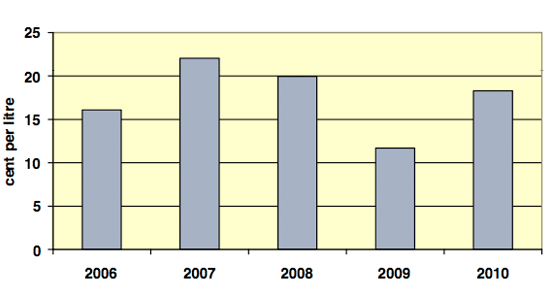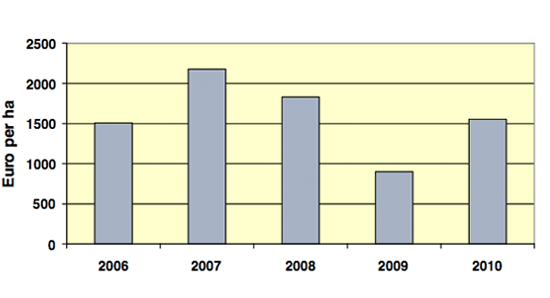



Irish Situation And Outlook For Dairying
A sharp rise in international butter and powder prices, coupled with favourable exchange rate movements has seen a strong recovery in Irish milk prices in the peak milk production season. With overall production costs largely unchanged, this means that 2010 will see a significant improvement in dairy farm margins relative to 2009.Mid-year update for 2010
A sharp rise in international butter and powder prices, coupled with favourable exchange rate movements has seen a strong recovery in Irish milk prices in the peak milk production season. With overall production costs largely unchanged, this means that 2010 will see a significant improvement in dairy farm margins relative to 2009. This paper considers the situation on dairy farms in the year to date and looks at the outlook for 2010 as a whole.
As of July 2010 indications are that costs on da iry farms are set to decrease slightly relative to 2009. Feed and fertiliser prices have moderated in 2010 and have now returned to levels that prevailed in advance of the commodity price boom in 2007/08. Purchased feed (concentrates) typically accounts for about 20 per cent of total input expenditure on dairy farms, although this varies by farm and by year. Dairy meal prices fell through out 2009 and at the beginning of 2010 were at the ir lowest level since 2006. This reflects the low cereal harvest price in Ireland and the moderation in international grain prices in 2009. There has been some upward movement in feed prices in the first half of 2010. However, it appears that the average feed prices for 2010 will be down about 5 per cent on the 2009 level.
Despite the unfavourable weather during 2009, dairy feed use in Ireland was down 10 per cent due to the low milk price and the contraction in Irish milk production. Data for the first 3 months of 2010 provided by DAFF indicates that aggregate dairy feed purchases were in line with the first quarter of 2009. However, in the second quarter of 2010 milk prices have been rising and the pattern of Irish milk production is closer to milk quota levels, which suggests that feed use could increase on the 2009 level. Weather conditions have been variable in 2010 and while favouring grass growth in some regions, a shortage of rain slowed grass growth elsewhere. Weather conditions remain an uncertain factor in determining the level of feed use for the year but it is estimated that feed use should increase by about 10 per cent. In 2010 expenditure on feed is forecast to be up 5 per cent, with the decrease in price more than offset by the increase in volume relative to the 2009 level
Pasture and forage costs are largely accounted for by fertiliser and contracting costs . Nitrogen based fertiliser prices followed a downward path through 2009 due to an excess of production over consumption globally, which led to rising stock levels. Fertiliser price movements in the first half of 2010 have been generally downward, although the rise in CAN prices has been an exception. For 2010 as a whole, fertiliser expenditure could be down by 10 per cent on the 2009 level. Contracting costs may increase by 5 per cent to reflect increasing fuel costs and the impact which the carbon tax will have on contractors’ own fuel costs. Overall, on grassland farms a reduction in pasture and forage expendit ures of 3 per cent is anticipated for 2010 relative to 2 009.
Electricity typically comprises about 30 per cent of the total expenditure on energy and fuel with fuel accounting for the remaining 70 per cent. At almost US $78 per barrel in July 2010, crude oil prices have been trending upwards in recent months and were higher in the first half of 2010 than in 2009 when the average price for the year was US $61. The CSO fuel price index has been moving upwards thus far in 2010, due to the higher crude oil price, the depreciation of the euro against the US dollar, and the introduction of the carbon tax on fossil fuels in Ireland. If oil futures prices are accurate, an average crude oil price of US $ 77 for the year 2010 as a whole is likely and this would represent a 25 per cent increase in US$ crude oil prices relative to 2009 and or an increase of 36 per cent in euro terms at prevailing euro dollar exchange rates. This could mean that dairy farmers are facing an increase of at least 20 per cent in fuel prices in 2010 relative to 2009. Electricity prices were reduced in May and October of 2009 and have remained at the October 2009 thus far in 2010. Barring an increase in electricity prices in the second half of 2010, it is likely that average electricity prices for 2010 will be down about 5 per cent on the 2009 level. On balance energy expenditure is likely on rise in 2010 on dairy farms by about 13 per cent .
Given the continuing high unemployment rate, labour costs in 2010 are likely to be unchanged on the 2009 level. Other miscellaneous costs look like they will decl ine by 2 per cent in 2010 relative to the 2009 level. Taken together all of these input expenditure changes would deliver a slight increase in direct cost s on Irish dairy farms of about 1 per cent in 2010 compared with the 2009 level. Producer milk prices in Ireland opened 2010 at about 27 cent per litre and have risen gradually in the year , reaching 30 cent per litre by June 2010. The increase in milk prices reflects a shortage of basic commodities on the international market as economic growth rates in developing economies promote food consumption . The European Commission suspended dairy export subsidies towards the end of 2009 as markets improved. Tighter supplies and stronger consumption have pushed butter and power prices upwards in 2010. As was the case in 2007, this has meant that Irish milk prices have increased to a greater extent than elsewhere in the EU due to the Irish dairy sector’s greater presence in third country markets.
Due to the seasonality of production, the rise in milk pric es in the second quarter of 2010 will greatly benefit the annual average milk prices for the year . Irish milk prices at or above 30 cent per litre should be sustainable for the peak milk delivery period. However, prices are likely to moderate later in the year. EU intervention stocks remain an issue and their disposal may place downward pressure on prices in the second half of 2010. At present the annual average milk price in Ireland looks like being about 29 cent per litre in 2010. This would represent an increase in price of over 25 per cent compared with 2009.
Figure 1: Monthly Irish Producer Milk Prices 2006 to 2010

Reflecting the higher producer milk price, Irish milk production in the 2010/11 milk quota year is set to recover from the depressed levels of 2008/09 and 2009/10. Although milk production in the early months of the 2010/11 quota year was only on a par with the corresponding months of 2009/10, June 2010 milk deliveries were up almost 11 per cent on the June 2009 level. If July and August 2010 production also exceed the 2009 level, it seems likely that production in 2010 as a whole will be up by at least 6 per cent on the 2009 calendar year. If late season production runs ahead of normal then this will take production closer to the milk quota level. Overall, gross output values on Irish dairy farms will be up by at least 25 per cent per litre in 2010 relative to 2009. With a moderate reduction in input costs, gross margins are likely to be about 18 cent per litre on average.
Figure 2: Gross margin per litre for Irish Creamery Milk Producers 2006 to 2010

Given the anticipated increase in both milk price and in milk output per hectare, the increase in gross margin per hectare is forecast to be over 70 per cent in 2010 relative to 2009.
Figure 3: Gross margin per hectare for Irish Creamery Milk Producers 2006 to 2010

Further Reading
| - | You can view the full report by clicking here. |


